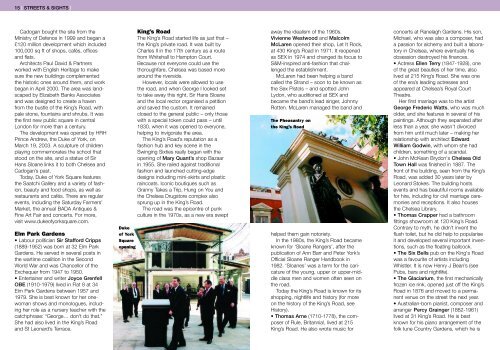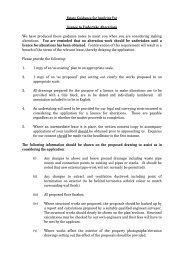The best of Chelsea by the people who know - Cadogan
The best of Chelsea by the people who know - Cadogan
The best of Chelsea by the people who know - Cadogan
You also want an ePaper? Increase the reach of your titles
YUMPU automatically turns print PDFs into web optimized ePapers that Google loves.
15 | STREETS & SIGHTS |<br />
<strong>Cadogan</strong> bought <strong>the</strong> site from <strong>the</strong><br />
Ministry <strong>of</strong> Defence in 1999 and began a<br />
£120 million development which included<br />
100,000 sq ft <strong>of</strong> shops, cafés, <strong>of</strong>fices<br />
and flats.<br />
Architects Paul David & Partners<br />
worked with English Heritage to make<br />
sure <strong>the</strong> new buildings complemented<br />
<strong>the</strong> historic ones around <strong>the</strong>m, and work<br />
began in April 2000. <strong>The</strong> area was landscaped<br />
<strong>by</strong> Elizabeth Banks Associates<br />
and was designed to create a haven<br />
from <strong>the</strong> bustle <strong>of</strong> <strong>the</strong> King’s Road, with<br />
pale stone, fountains and shrubs. It was<br />
<strong>the</strong> first new public square in central<br />
London for more than a century.<br />
<strong>The</strong> development was opened <strong>by</strong> HRH<br />
Prince Andrew, <strong>the</strong> Duke <strong>of</strong> York, on<br />
March 19, 2003. A sculpture <strong>of</strong> children<br />
playing commemorates <strong>the</strong> school that<br />
stood on <strong>the</strong> site, and a statue <strong>of</strong> Sir<br />
Hans Sloane links it to both <strong>Chelsea</strong> and<br />
<strong>Cadogan</strong>’s past.<br />
Today, Duke <strong>of</strong> York Square features<br />
<strong>the</strong> Saatchi Gallery and a variety <strong>of</strong> fashion,<br />
beauty and food shops, as well as<br />
restaurants and cafés. <strong>The</strong>re are regular<br />
events, including <strong>the</strong> Saturday Farmers'<br />
Market, <strong>the</strong> annual BADA Antiques &<br />
Fine Art Fair and concerts. For more,<br />
visit www.duke<strong>of</strong>yorksquare.com.<br />
Elm Park Gardens<br />
• Labour politician Sir Stafford Cripps<br />
(1889-1952) was born at 32 Elm Park<br />
Gardens. He served in several posts in<br />
<strong>the</strong> wartime coalition in <strong>the</strong> Second<br />
World War and was Chancellor <strong>of</strong> <strong>the</strong><br />
Exchequer from 1947 to 1950.<br />
• Entertainer and writer Joyce Grenfell<br />
OBE (1910-1979) lived in Flat 8 at 34<br />
Elm Park Gardens between 1957 and<br />
1979. She is <strong>best</strong> <strong>know</strong>n for her onewoman<br />
shows and monologues, including<br />
her role as a nursery teacher with <strong>the</strong><br />
catchphrase: “George… don’t do that.”<br />
She had also lived in <strong>the</strong> King’s Road<br />
and St Leonard’s Terrace.<br />
Duke<br />
<strong>of</strong> York<br />
Square<br />
opening<br />
King’s Road<br />
<strong>The</strong> King’s Road started life as just that –<br />
<strong>the</strong> King’s private road. It was built <strong>by</strong><br />
Charles II in <strong>the</strong> 17th century as a route<br />
from Whitehall to Hampton Court.<br />
Because not everyone could use <strong>the</strong><br />
thoroughfare, <strong>Chelsea</strong> was based more<br />
around <strong>the</strong> riverside.<br />
However, locals were allowed to use<br />
<strong>the</strong> road, and when George I looked set<br />
to take away this right, Sir Hans Sloane<br />
and <strong>the</strong> local rector organised a petition<br />
and saved <strong>the</strong> custom. It remained<br />
closed to <strong>the</strong> general public – only those<br />
with a special token could pass – until<br />
1830, when it was opened to everyone,<br />
helping to invigorate <strong>the</strong> area.<br />
<strong>The</strong> King’s Road’s reputation as a<br />
fashion hub and key scene in <strong>the</strong><br />
Swinging Sixties really began with <strong>the</strong><br />
opening <strong>of</strong> Mary Quant’s shop Bazaar<br />
in 1955. She railed against traditional<br />
fashion and launched cutting-edge<br />
designs including mini-skirts and plastic<br />
raincoats. Iconic boutiques such as<br />
Granny Takes a Trip, Hung on You and<br />
<strong>the</strong> <strong>Chelsea</strong> Drugstore complex also<br />
sprung up in <strong>the</strong> King’s Road.<br />
<strong>The</strong> road was <strong>the</strong> epicentre <strong>of</strong> punk<br />
culture in <strong>the</strong> 1970s, as a new era swept<br />
away <strong>the</strong> idealism <strong>of</strong> <strong>the</strong> 1960s.<br />
Vivienne Westwood and Malcolm<br />
McLaren opened <strong>the</strong>ir shop, Let It Rock,<br />
at 430 King’s Road in 1971. It reopened<br />
as SEX in 1974 and changed its focus to<br />
S&M-inspired anti-fashion that challenged<br />
<strong>the</strong> establishment.<br />
McLaren had been helping a band<br />
called <strong>the</strong> Strand – soon to be <strong>know</strong>n as<br />
<strong>the</strong> Sex Pistols – and spotted John<br />
Lydon, <strong>who</strong> auditioned at SEX and<br />
became <strong>the</strong> band’s lead singer, Johnny<br />
Rotten. McLaren managed <strong>the</strong> band and<br />
<strong>The</strong> Pheasantry on<br />
<strong>the</strong> King’s Road<br />
helped <strong>the</strong>m gain notoriety.<br />
In <strong>the</strong> 1980s, <strong>the</strong> King’s Road became<br />
<strong>know</strong>n for ‘Sloane Rangers’, after <strong>the</strong><br />
publication <strong>of</strong> Ann Barr and Peter York’s<br />
Official Sloane Ranger Handbook in<br />
1982. ‘Sloanes’ was a term for <strong>the</strong> caricature<br />
<strong>of</strong> <strong>the</strong> young, upper or upper-middle<br />
class men and women <strong>of</strong>ten seen on<br />
<strong>the</strong> road.<br />
Today <strong>the</strong> King’s Road is <strong>know</strong>n for its<br />
shopping, nightlife and history (for more<br />
on <strong>the</strong> history <strong>of</strong> <strong>the</strong> King’s Road, see<br />
History).<br />
• Thomas Arne (1710-1778), <strong>the</strong> composer<br />
<strong>of</strong> Rule, Britannia!, lived at 215<br />
King’s Road. He also wrote music for<br />
concerts at Ranelagh Gardens. His son,<br />
Michael, <strong>who</strong> was also a composer, had<br />
a passion for alchemy and built a laboratory<br />
in <strong>Chelsea</strong>, where eventually his<br />
obsession destroyed his finances.<br />
• Actress Ellen Terry (1847-1928), one<br />
<strong>of</strong> <strong>the</strong> great beauties <strong>of</strong> her time, also<br />
lived at 215 King’s Road. She was one<br />
<strong>of</strong> <strong>the</strong> era’s leading actresses and<br />
appeared at <strong>Chelsea</strong>’s Royal Court<br />
<strong>The</strong>atre.<br />
Her first marriage was to <strong>the</strong> artist<br />
George Frederic Watts, <strong>who</strong> was much<br />
older, and she features in several <strong>of</strong> his<br />
paintings. Although <strong>the</strong>y separated after<br />
less than a year, she wasn’t divorced<br />
from him until much later – making her<br />
relationship with architect Edward<br />
William Godwin, with <strong>who</strong>m she had<br />
children, something <strong>of</strong> a scandal.<br />
• John McKean Brydon's <strong>Chelsea</strong> Old<br />
Town Hall was finished in 1887. <strong>The</strong><br />
front <strong>of</strong> <strong>the</strong> building, seen from <strong>the</strong> King’s<br />
Road, was added 30 years later <strong>by</strong><br />
Leonard Stokes. <strong>The</strong> building hosts<br />
events and has beautiful rooms available<br />
for hire, including for civil marriage ceremonies<br />
and receptions. It also houses<br />
<strong>the</strong> <strong>Chelsea</strong> Library.<br />
• Thomas Crapper had a bathroom<br />
fittings showroom at 120 King’s Road.<br />
Contrary to myth, he didn’t invent <strong>the</strong><br />
flush toilet, but he did help to popularise<br />
it and developed several important inventions,<br />
such as <strong>the</strong> floating ballcock.<br />
• <strong>The</strong> Six Bells pub on <strong>the</strong> King's Road<br />
was a favourite <strong>of</strong> artists including<br />
Whistler. It is now Henry J Bean’s (see<br />
Pubs, bars and nightlife).<br />
• <strong>The</strong> Glaciarium, <strong>the</strong> first mechanically<br />
frozen ice rink, opened just <strong>of</strong>f <strong>the</strong> King’s<br />
Road in 1876 and moved to a permanent<br />
venue on <strong>the</strong> street <strong>the</strong> next year.<br />
• Australian-born pianist, composer and<br />
arranger Percy Grainger (1882-1961)<br />
lived at 31 King’s Road. He is <strong>best</strong><br />
<strong>know</strong>n for his piano arrangement <strong>of</strong> <strong>the</strong><br />
folk tune Country Gardens, which he is







